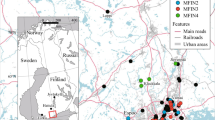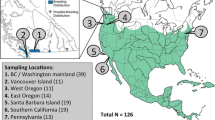Abstract
The Woodpigeon Columba palumbus is an abundant and widespread Palearctic species that uses multiple flyways in Europe. The designation of the main flyways of Woodpigeon in Europe and the study of the genetic structure of the populations are necessary for the sustainable management of this species. Both ringing recovery data of Woodpigeons and mtDNA D-loop sequences from 606 individuals sampled across Europe and in Morocco were used in this study. In total, 763 direct recoveries of birds ringed during the breeding season in 1908–2016 were analysed, while D-loop sequences were analysed from 416 birds sampled in 2014–2018 and 190 individuals that had been sampled in 2004–2009 for a preliminary investigation. In the median-joining network of D-loop haplotypes, six haplogroups were identified in Woodpigeons from various biogeographical populations. Certain differences in the frequency of haplogroups were found between resident Woodpigeons of the Iberian Peninsula and migratory birds from Eastern and Northern Europe. Relatively low genetic variability within the D-loop was observed in samples of resident birds from the Balearic Islands and the Iberian Peninsula. No genetic variation was found in resident Woodpigeons breeding in Morocco. The analysis of ringing recovery data and distribution patterns of different haplotypes confirmed that Woodpigeons from the north and east of Europe use the Eastern Atlantic flyway, while birds breeding in Hungary use the Mediterranean flyway. It is likely that Woodpigeons from south-eastern Russia, eastern Ukraine and birds breeding further east use the Black Sea flyway. It was also confirmed that the majority of Woodpigeons breeding in Belgium are resident or short-distance migrants. Due to the variability identified in the genetic make-up of different populations of Woodpigeons in Europe, we remark the management implications regarding the species that are relevant in various regions of the continent.






Similar content being viewed by others
Change history
06 December 2019
Figures 1-3 need to be replaced to cover the facts correctly.
References
Aljanabi SM, Martinez I (1997) Universal and rapid salt-extraction of high quality genomic DNA for PCR-based techniques. Nucleic Acids Res 25:4692–4693
Atkinson-Wiles G, Scott D, Prater A (1982) Criteria for selecting wetlands of international importance. Proceedings of the International Conference on Wetlands of International Importance, Particularly as Waterfowl Habitats. Ricerche di Biologia della Selvaggina 8:1017–1042
Bagi Z, Dimopoulos EA, Loukovitis D, Eraud C, Kusza S (2018) MtDNA genetic diversity and structure of Eurasian Collared Dove (Streptopelia decaocto). PLoS One 13(3):e0193935
Bandelt H-J, Forster P, Röhl A (1999) Median-joining networks for inferring intraspecific phylogenies. Mol Biol Evol 16:37–48
Bankovics A (2001) The migration of woodpigeon (Columba palumbus) and Turtle Dove (Streptopelia turtur) in Hungary. Naturzale 16:83–93
Bea A, Beitia R, Fernández JM (2003) The census and distribution of wintering woodpigeons Columba palumbus in the Iberian peninsula. Ornis Hung 12-13:157–167
Bea A, Svazas S, Grishanov G, Kozulin A, Stanevicius V, Astafieva T, Olano I, Raudonikis L, Butkauskas D, Sruoga A (2011) Woodland and urban populations of the woodpigeon Columba palumbus in the Eastern Baltic region. Ardeola 58:315–321
BirdLife International (2018) The BirdLife checklist of the birds of the world: Version 8
Butkauskas D, Švažas S, Sruoga A, Bea A, Grishanov G (2008) Variability of haplotypes among different populations of Woodpigeon (Columba palumbus) in Southern Europe and in the Eastern Baltic Region. Acta Zool Litu 18:77–82
Butkauskas D, Švažas S, Tubelytė V, Morkūnas J, Sruoga A, Boiko D, Paulauskas A, Stanevičius V, Baublys V (2012) Coexistence and population genetic structure of the Whooper Swan Cygnus cygnus and Mute Swan Cygnus olor in the Eastern Baltic Region. Cent Eur J Biol 7:887–894
Butkauskas D, Švažas S, Sruoga A, Bea A, Grishanov G, Kozulin A, Olano I, Stanevičius V, Tubelytė V, Ragauskas A (2013) Genetic techniques for designation of main flyways of the woodpigeon (Columba palumbus) in Europe as a tool for control and prevention of pathogenic diseases. Vet Med Zoot 63:12–16
Calderón L, Campagna L, Wilke T, Lormee H, Eraud C, Dunn J, Rocha G, Zehtindjiev P, Bakaloudis D, Metzger B, Cecere J, Marx M, Quillfeldt P (2016) Genomic evidence of demographic fluctuations and lack of genetic structure across flyways in a long distance migrant, the European turtle dove. BMC Evol Biol 16:237
Cohou V (2011) Monitoring of woodpigeon migrations and their spatial and temporal evolution. Results induced by new technologies. In: Puigcerver M, Rodriguez-Teijeiro JD, Buner F. (eds), Abstracts of the 30th IUGB Congress Barcelona, Spain. P. 238
Cramp S (ed) (1985) The birds of the Western Palearctic. Vol 6. Oxford University Press, Oxford
Dourado CG (2011) Phylogeny and phylogeography of Atlantic Islands Columba species. Dissertation, University of Lisbon
Dourado CG, Duarte MA, Grosso AR, Bastos-Silveira C, Marrero P, Oliveira P, Paulo OS, Dias D (2013) Phylogenetic origin of the endemic pigeons from Madeira (Columba trocaz) and Azores Islands (Columba palumbus azorica). J Ornithol 155:71–82
Dupanloup I, Schneider S, Excoffier L (2002) A simulated annealing approach to define the genetic structure of populations. Mol Ecol 11:2571–2581
Excoffier L, Smouse PE, Quattro JM (1992) Analysis of molecular variance inferred from metric distances among DNA haplotypes: application to human mitochondrial DNA restriction data. Genetics 131:479–491
Excoffier L, Laval G, Schneider S (2005) Arlequin version 3.0, An integrated software package for population genetics data analysis. Evol Bioinformatics Online 1:47–50
Facon B, Genton B, Shykoff J, Jarne P, Estoup A, David P (2006) A general ecoevolutionary framework for understanding bioinvasions. Trends Ecol Evol 21:130–135
Faragó S (2009) Woodpigeon. In: Csörgő T, Karcza Z, Halmos G, Magyar G, Gyurácz J, Szép T, Bankovics A, Schmidt A, Schmidt E (eds). Hungarian bird migration atlas. Budapest, Kossuth Kiadó. 672 p. (in Hungarian)
Fu YX (1997) Statistical tests of neutrality of mutations against population growth, hitchhiking and background selection. Genetics 147:915–925
González J, Wink M, Garcia-del-Rey E, Delgado G (2008) Evidence from DNA nucleotide sequences and ISSR profiles indicates paraphyly in subspecies of southern grey shrike (Lanius meridionalis). J Ornithol 149:495–506
Grosso AR, Bastos-Silveira C, Coelho MM, Dias D (2006) Columba palumbus Cyt b-like Numt sequence: comparison with functional homologue and the use of universal primers. Folia Zool 55:131–144
Hagemeijer EJM, Blair MJ (eds) (1997) The EBCC atlas of European breeding birds: their distribution and abundance. T & A D Poyser, London
Heusmann H (1999) Special hunting seasons and resident Canada goose populations. Wildl Soc Bull 27:456–464
Hobson K, Lormée H, van Wilgenburg S, Wassenaar L, Boutin J (2009) Stable isotopes (D) delineate the origins and migratory connectivity of harvested animals: the case of European Woodpigeons. J Appl Ecol 46:572–581
Krapu G, Brandt D, Jones K, Johnson D (2011) Geographic distribution of the mid-continent population of sandhill cranes and related management applications. Wildl Monogr 175:1–38
Kraus RH, Zeddeman A, Hooft P, Sartakov D, Soloviev SA, Ydenberg RC, Prins HH (2011) Evolution and connectivity in the world-wide migration system of the mallard: inferences from mitochondrial DNA. BMC Genet 12:99
Kumar S, Stecher G, Li M, Knyaz C, Tamura K (2018) MEGA X: Molecular evolutionary genetics analysis across computing platforms. Mol Biol Evol 35:1547–1549
Lane AB (1984) An enquiry into the responses of growers to attacks by pests on oilseed rape (Brassica napus), a relatively new crop in the United Kingdom. Prot Ecol 7:73–78
Librado P, Rozas J (2009) DnaSP v5: a software for comprehensive analysis of DNA polymorphism data. Bioinformatics 25:1451–1452
Madsen J, William JH, Johnson FA, Tombre I, Dereliev S, Kuijken E (2017) Implementation of the first adaptive management plan for a European migratory waterbird population: the case of the Svalbard Pink-footed Goose Anser brachyrhynchus. Ambio 46(Suppl. 2):275–289
Mischenko A, Fedosov V, Tilba P, Sukhanova O, Mezhnev A (2013) Numbers and ecology of Woodpigeon (Columba palumbus) in different regions of European Russia. Vest Ochot:167–176 (in Russian)
Nei M (1978) Estimation of average heterozygosity and genetic distance from a small number of individuals. Genetics 23:341–369
Peakall R, Smouse PE (2012) GenAlEx 6.5: genetic analysis in Excel. Population genetic software for teaching and research–an update. Bioinformatics 28:2537–2539
Puigcerver M, Vinyoles D, Rodríguez-Teijeiro D (2007) Does restocking with Japanese quail or hybrids affect native populations of common quail Coturnix coturnix? Biol Conserv 136:628–635
Ramos-Onsins SE, Rozas J (2002) Statistical properties of new neutrality tests against population growth. Mol Biol Evol 19:2092–2100
Reed D, Frankham R (2003) Correlation between fitness and genetic diversity. Conserv Biol 17:230–237
Rouxel R, Czajkowski A (2004) Le Pigeon Ramier (Columba palumbus) (ed. OMPO). Societe de Presse Adour-Pyrenees, Lourdes
Santiago-Alarcon D, Tanksley SM, Parker PG (2006) Morphological variation and genetic structure of Galapagos dove (Zenaida galapagoensis) populations: issues in conservation for the Galapagos bird fauna. Wilson J Ornithol 118(2):194–207
Seki SI, Takano H, Kawakami K, Kotoka N (2007) Distribution and genetic structure of the Japanese wood pigeon (Columba janthina) endemic to the islands of East Asia. Conserv Genet 8(5):1109–1121
Shephard JM, Ogden R, Tryjanowski P, Olsson O, Galbusera P (2013) Is population structure in the European white stork determined by flyway permeability rather than translocation history? Ecol Evol 3:4881–4895
Sruoga A, Butkauskas D, Švažas S, Bea A, Mozalienė E (2005) Identification of flyways of Woodpigeon (Columba palumbus) in Europe by using genetic methods. Acta Zool Litu 15:248–253
Tajima F (1989) Statistical method for testing the neutral mutation hypothesis by DNA polymorphism. Genetics 123:585–595
Tamura K, Nei M (1993) Estimation of the number of nucleotide substitutions in the control region of mitochondrial DNA in humans and chimpanzees. Mol Biol Evol 9:512–526
Thompson J, Higgins D, Gibson T (1994) CLUSTAL W: improving the sensitivity of progressive multiple sequence alignment through sequence weighting, position-specific gap penalties and weight matrix choice. Nucleic Acids Res 22:4673–4690
Tubelytė V, Švažas S, Sruoga A, Butkauskas D, Paulauskas A, Baublys V, Viksne J, Grishanov G, Kozulin A (2011) Genetic diversity of tufted ducks (Aythya fuligula) in Eastern Europe. Cent Eur J Biol 6:1044–1053
Villesen P (2007) FaBox: an online toolbox for fasta sequences. Mol Ecol Notes 7:965–968
Wilson RE, Ely CR, Talbot SL (2018) Flyway structure in the circumpolar greater white-fronted goose. Ecol Evol 8:8490–8507
Acknowledgements
Implementation of this study would have been impossible without support of the Lithuanian Nature Research Centre and the Hunting Federation of the Basque Country, Spain. We are grateful to EURING (the coordinating organisation for European bird ringing schemes) and the Russian Bird Ringing Centre for provided access to ringing recoveries data. We extend our sincere thanks to all experts and organisations from nine countries for their participation in this research. We thank editors and anonymous reviewers for scientific comments on the manuscript, and Jos Stratford for language corrections. All applicable national and institutional guidelines for the use of wild birds were followed in this research.
Author information
Authors and Affiliations
Corresponding author
Additional information
Publisher’s note
Springer Nature remains neutral with regard to jurisdictional claims in published maps and institutional affiliations.
Rights and permissions
About this article
Cite this article
Butkauskas, D., Švažas, S., Bea, A. et al. Designation of flyways and genetic structure of Woodpigeon Columba palumbus in Europe and Morocco. Eur J Wildl Res 65, 91 (2019). https://doi.org/10.1007/s10344-019-1336-9
Received:
Revised:
Accepted:
Published:
DOI: https://doi.org/10.1007/s10344-019-1336-9




